 W
WThe chorus cicada, Amphipsalta zelandica, is the most common species of cicada in New Zealand, where it is endemic and found in most areas. They typically live in forests and areas with open bush, where their left-over nymph skins can be seen on tree trunks and branches during the summer months. The males produce their cicada sound in unison, which can reach deafening proportions at the height of their population around February. Groups of cicada can suddenly transition from the typical cicada sound to synchronised clicks, using their wings to clap against the surface they are sitting on.
 W
WAntianthe expansa, known generally as the keeled tree hopper or solanaceous treehopper, is a species of treehopper in the family Membracidae.
 W
WThe ash whitefly is a species of whitefly native to western Eurasia, India and North Africa but also introduced to North America. It is known in agriculture as a pest species of fruit trees, including pomegranates, pear and apple trees. It also feeds on ash and ornamental pear trees. Encarsia inaron is used as a biological control for it.
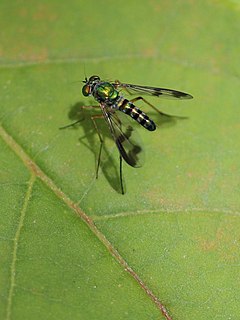 W
WAustrosciapus connexus, the green long-legged fly is an Australian insect in the family Dolichopodidae.
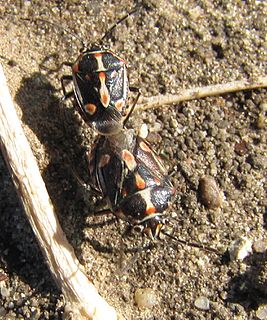 W
WBagrada hilaris is a species of shield bug known by the common names bagrada bug and painted bug (See a short video at YouTube). It could be mistaken for or erroneously referred to as harlequin bug. It is native to Africa. It is known elsewhere as an introduced species, including California and Arizona, where it was first reported in 2008. It is a major pest insect of Brassica oleracea crops, and related crucifers such as turnips, rape, and mustard. The adult and nymph of the species suck sap from the leaves of the plants, causing wilting, yellowing, and stunting of growth. Besides crucifers, the bugs are known on papaya, sorghum, maize, potato, cotton, caper, pearl millet, and some legumes. Large numbers of the bug congregate on the plants and cause extensive damage.
 W
WBerytinus minor is a species of stilt bug in the family Berytidae. It is found in Africa, Europe & Northern Asia, and North America.
 W
WThe blue ant, also known as the blue-ant or bluebottle is, despite its name and its appearance, not an ant, but rather a species of large solitary parasitic wasp sometimes known as a flower wasp. It is a native of south and southeast Australia, including the Australian states of Tasmania, New South Wales, Victoria and South Australia. It is the sole member of the subfamily Diamminae and the genus Diamma, and is both morphologically and behaviorally unusual among members of the family Tiphiidae.
 W
WBombus dahlbomii is a species of bumblebee endemic to southern South American temperate forests. B. dahlbomii is one of the largest bee species in the world, with matured queens growing up to 40 mm (1.6 in) long. Because of its size and furry appearance, the species has been described as "flying mice" colloquially, and "a monstrous fluffy ginger beast" by British ecologist David Goulson.
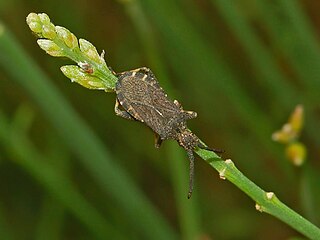 W
WBothrostethus annulipes is a species of Coreidae family, subfamily Pseudophloeinae.
 W
WCalocoris affinis is a species of insect in the subfamily Mirinae of the family Miridae that can be found everywhere in Europe except for Switzerland and Greece.
 W
WCampyloneura virgula is a species of bugs in Miridae family. It is the only species in the genus Campyloneura Fieber, 1861.
 W
WThe cat flea is an extremely common parasitic insect whose principal host is the domestic cat, although a high proportion of the fleas found on dogs also belong to this species. This is despite the widespread existence of a separate and well-established "dog" flea, Ctenocephalides canis.
 W
WChelinidea tabulata is a species of leaf-footed bugs in the family Coreidae. It is found in Central America, North America, and South America.
 W
WClosterotomus biclavatus is a plant bug belonging to the family Miridae, subfamily Mirinae. The species was first described by Gottlieb August Wilhelm Herrich-Schäffer in 1835.
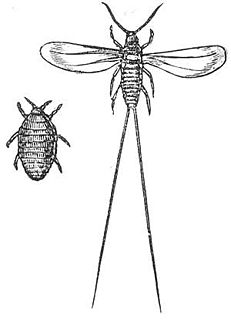 W
WThe cochineal is a scale insect in the suborder Sternorrhyncha, from which the natural dye carmine is derived. A primarily sessile parasite native to tropical and subtropical South America through North America, this insect lives on cacti in the genus Opuntia, feeding on plant moisture and nutrients. The insects are found on the pads of prickly pear cacti, collected by brushing them off the plants, and dried.
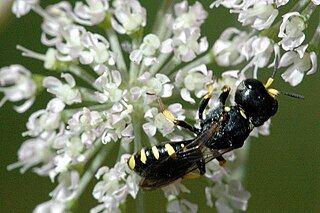 W
WEctemnius dives is a species of square-headed wasp in the family Crabronidae. It is found in Europe & Northern Asia, North America, and Southern Asia.
 W
WEmpis digramma is a species of dance flies, in the fly family Empididae. The thorax is gray with yellowish sides, with two dark stripes following the line of the dorsocentral bristles. Abdomen is gray upper and yellowish on the sides. The fly's length is 5–7.5 millimetres (0.2–0.3 in).
 W
WEpisyron quinquenotatus, the white-trimmed black wasp, is a North American species of pompilid spider hunting wasp.
 W
WEurycantha horrida, the thorny devil walking stick, is a species belonging to the stick insects and to the family Phasmatidae.
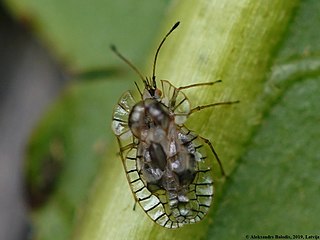 W
WGaleatus affinis is a species of lace bug in the family Tingidae. It is found in Europe & Northern Asia, North America, and Southern Asia.
 W
WHallodapus rufescens is a Palearctic species of true bug
 W
WLabena grallator is a species of ichneumon wasp in the family Ichneumonidae.
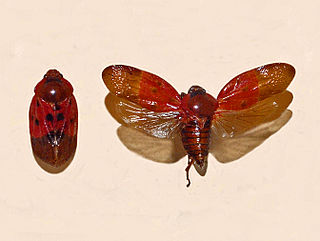 W
WLeptataspis discolor is a species of froghoppers belonging to the family Cercopidae.
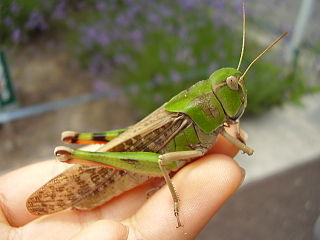 W
WLocusta migratoria manilensis, commonly known as the Oriental migratory locust, is a subspecies of the migratory locust in the family Acrididae. It is sufficiently different in size and structure from the African migratory locust to be considered a distinct subspecies of the migratory locust. It is found in southeastern Asia and is an important agricultural pest in the region. It is normally a solitary insect but when conditions are suitable, it enters into a gregarious phase when the young form into bands which move together and the adults into swarms. Although outbreaks may have recently been fewer in number and size because of changes in agricultural practices and better locust detection, the insects remain active as crop pests and the potential for outbreaks is still present.
 W
WLygus gemellatus is a species of plant-feeding insects in the family Miridae.
 W
WLymeon orbus is a species of ichneumon wasp in the family Ichneumonidae.
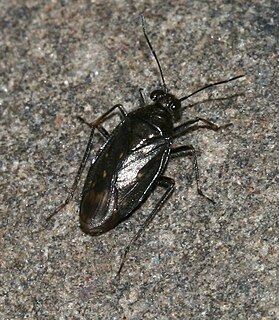 W
WMacrosaldula scotica is a predatory species of true bug, from the family Saldidae in the order Hemiptera from the western Palearctic.
 W
WMeromyza femorata is a species of fly in the family Chloropidae. It is found in the Palearctic.
 W
WMetallyticus splendidus is a very rare species of praying mantis found in Southeast Asia. It has an iridescent appearance.
 W
WMicrovelia reticulata is a Palearctic species of true bug. It is aquatic.
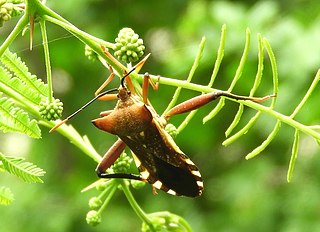 W
WMozena lunata is a species of leaf-footed bug in the family Coreidae. It is found in Central America and North America.
 W
WMydas maculiventris is a species of mydas flies in the family Mydidae.
 W
WOrthocephalus saltator is a Palearctic species of plant bug in the family Miridae. It is found in Europe as far as the Caspian Sea and Siberia and to the south North Africa. O. saltator feeds on Asteraceae especially Hieracium pilosella and Poaceae
 W
WParaleptophlebia submarginata is a species of prong-gilled mayfly in the family Leptophlebiidae.
 W
WPardalophora apiculata, known generally as the coral-winged grasshopper or coral-winged locust, is a species of band-winged grasshopper in the family Acrididae. It is found in North America.
 W
WPhobaeticus serratipes is a species of stick insect that at one time was the longest known insect, with one female specimen recorded as being 555 mm long. This measurement includes the legs fully extended front and rear, and the actual length of the body alone is considerably shorter. This insect is endemic to Malaysia and Singapore. It is a popular species among those who raise stick insects.
 W
WThe pink-winged phasma is a species of phasmid that is endemic to Australia.
 W
WPseudochorthippus curtipennis, known generally as marsh meadow grasshopper, is a species of slant-faced grasshopper in the family Acrididae. Other common names include the meadow grasshopper and short-winged brown grasshopper. It is found in North America.
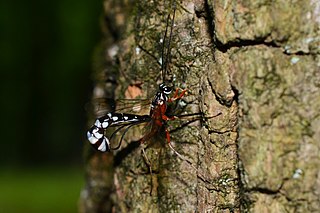 W
WRhyssella humida is a species of ichneumon wasp in the family Ichneumonidae.
 W
WScaptia lata, coliguacho or tabano negro is a large horse fly whose range includes southern Chile and southern Argentina. The fly has a striking reddish-orange coloration on the side of its thorax and abdomen. It is generally around 2 cm. in adult size.
 W
WStagmomantis limbata, common name bordered mantis, bosque mantis, Arizona mantis, or New Mexico praying mantis is a species of praying mantis native to North America, most prevalent in the Southwestern United States. This beneficial insect is green or beige in color and grows up to around 3 inches long.
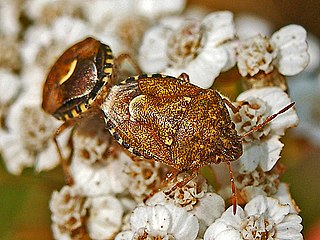 W
WStaria lunata is a species of shield bug belonging to the family Pentatomidae. It is the only species of the genus
 W
WTaeniaptera trivittata is a species of stilt-legged flies in the family Micropezidae.
 W
WTemnostethus pusillus is a true bug in the family Anthocoridae. The species is found in the West Palearctic. It is a small zoophage frequently occurring on ash or apple bark where it preys on aphids, leaf suckers, and scale insects (Coccidae)
 W
WTeratodes, commonly known as hooded grasshoppers, is a genus of grasshopper native to India and Sri Lanka. It was established by the French entomologist Gaspard Auguste Brullé in 1835.
 W
WTetraphleps bicuspis is a Palearctic species of true bug It is predatory.
 W
WThasus gigas is a species of leaf-footed bug in the family Coreidae. It is found in Central America and North America.